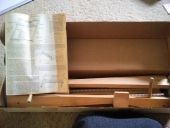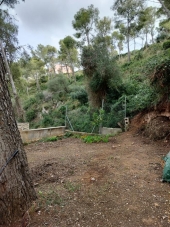Matteo Salusso has an interesting version of a rigid heddle which can be used with a variety of loom styles - from tapestry/frame to inkle to weighted warp to a pretty typical looking table loom. His YT channel has a bunch of videos showing various implementations of his "Pettineliccio tubolare" - "tubular rigid heddle" - which is made from plastic electrical conduit (as best as I can understand Italian). I've had exactly zero luck tracking down his Italian patent. Matteo is from the Piedmont - Val de Pellice to be precise - from a long line of weavers and loom builders. As an aside, the historic denizens of the valleys of the Italian Piedmont and the French side of the Cottian Alps above Lyons and Grenoble were the Vaudois/Valdese/Waldensians, who were known for their weaving (as well as being targets of The Inquisition for their heretical views which presaged the Swiss and German Reformers). Whether you could agree with their theological distinctives or not, their way of life seems to have been very "permie" from all written accounts I have found of them, many written by their accusers. But, I digress...
I've tried making one of Matteo's tubular rigid heddles from a recycled piece of 1 1/2" nominal plastic drain pipe (with a piece of repurposed political sign wire for the warp retainer rod), but deburring the sawn slits isn't easy, and they really do need to be smooth to prevent the warp from being frayed as the fabric is beaten. Matteo uses a wire wheel to deburr from the outside of the pipe (you can a quick view of it in one of his videos, I forget which), but I haven't yet been able to get the same results as he does. I did just pick up a 1 1/2" OD wire wheel from the hardware store, which I'll try mounting in a flexible shaft to reach inside the tubing to see if I can get better results with that arrangement. I may try a length of Carlon plastic conduit to see if I can get a cleaner cut than on the Genova drain pipe. 1 1/4" nominal plastic pipe may be a better fit for most people's hands than the 1 1/2" I have been messing with, but it is what I had on hand.
A good overview of his system can be seen here:
https://www.youtube.com/watch?v=hLTaOnVlE4c
Reviewing some of his other videos will show the flexibility of his heddle. His "Tessitura di strada" video shows how portable and minimalist it can be (he pulls everything out of a small backpack), while the "Pettineliccio Tubolare con Liccetti" shows what can be done in the way of fancy pattern weaving, albeit not as efficiently as with a multi-harness floor loom. If maximum output is your goal, Matteo's tubular heddle may not be for you. But, if you would like to have a lot of versatility with minimal outlay, it's worth a look.
If I can figure out a way of reliably deburring the edges of the slits in the plastic pipe, I'll be sure to post it here.
If you don't want to fool around with making your own, he'll sell you one:
https://www.telaisalusso.com/en-gb/il-pettineliccio-tubolare
Given the level of skill and the DIY mindset which prevails here, I'll bet some homemade ones will appear.

 2
2




 4
4











 2
2















 2
2




 4
4















 1
1



















 1
1










